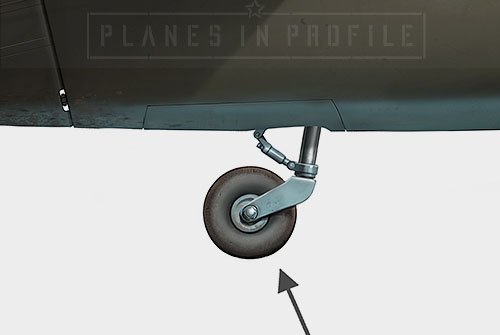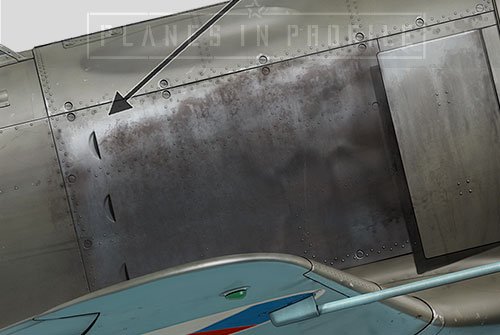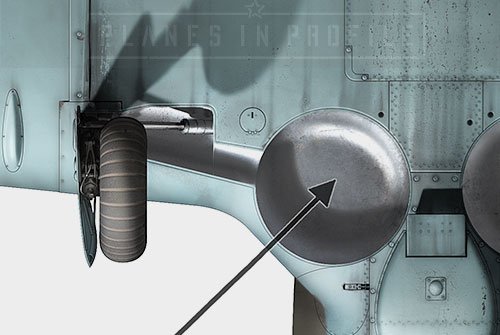“WHITE-79 / IW-6”,
Lavochkin, La-5FN (Late)
Airplane serial number 39213479, Engine serial number 82134364, Czech (re-registered) inventory number La5-3459 [1]
1. letka, 1. pluk, 4. letecka divize, Czechoslovak Air Force, Piešťany airfield, late August, 1946.
Flown by -unknown, most likely by various pilots of the unit.
IW-6 was originally a Soviet airplane with a serial number 39213479 and a white tactical number “79”. White-79 originally belonged to the 41st GIAP (Guards Fighter Aviation Regiment) of the Soviet VVS, an elite Soviet unit (a unit that was already mentioned on White-30’s page). When the 41st GIAP was re-equipped with La-7 airplanes in late 1944, 31 of its La-5FNs, including White-79 were passed on to the 1st čsslp (Czechoslovak Independent Fighter Regiment) on the 1st and 2nd of November 1944. [2] This was a very welcomed replenishment for the 1st čsslp because by that time, due to the intense battle action during the Slovak National Uprising, the 1st čsslp had only 7 of its original 20 La-5FNs left.
So, the 1st čsslp ended up with a total of 38 (31 + the original 7) machines. Because it suddenly had many more airplanes than pilots, the new pilots needed to be recruited and trained to fly the airplanes before any combat operations could be resumed. By the 14th of April 1945, after the 1st čsslp was restructured into 1. čs stíhací pluk and 2. čs stíhací pluk, the 1st pluk commenced battle action again, this time in the Moravia-Ostrava Offensive operation. Only about 19 pilots were operationally capable by that time, but on the bright side, the nature of battle missions and the conditions at the front have become easier compared to what the 1st čsslp experienced during the Slovak National Uprising. 255 out of 285 sorties flown by the 1.čs stíhací pluk in the Ostrava Offensive were escort missions for Il-2 Shturmoviks of the 3. čs bitevni pluk (3rd Czechoslovak Ground Attack Regiment) and were not as dangerous as before due to the limited Luftwaffe activity at this late stage in the war. During these escort sorties the La-5FNs of the 1.čs stíhací pluk were often able to carry their own bombs all the way to their destinations (as opposed to dropping them early in order to dogfight enemy airplanes) and were therefore able perform dive bombing and strafing attacks alongside the Shturmoviks. Other missions included reconnaissance work, and only about a dozen times did the La-5FNs scramble into the air to intercept enemy aircraft. Only 4 air-to-air engagements occurred during the Ostrava Offensive for the 1.čs stíhací pluk. No air victories were recorded but the fighter pilots of this regiment did damage one FW-190 and one BF-109. Thankfully, the Czech fighter regiment had not suffered any losses during the Ostrava Operation [3]. I was unable to find out who in particular flew White-79 during that time, but it’s most likely that it was flown by various pilots of the 1. čs stíhací pluk, which was a common practice in that unit.
At the end of the war the La-5FNs of the 1. and 2. čs stíhací pluks, including White-79, returned to Czechoslovakia, arriving to the Prague-Letnany airfield on the 18th of May 1945. A photo of White-79, shows what it looked like at the Prague-Letnany airfield on the 1st of June 1945. It’s worth noting that by this time it already had the propeller spinner painted red with a light-coloured (probably White or even silver?) base - the identification marking of the 1. letka (squadron) of the 1.čs stíhací pluk. In the same photo we can see the airplanes of the 2. letka in the background, with their propeller spinners painted white - the id. marking of the 2nd squadron.
The image above is a reconstruction of White-79 as it looked in early June 1945 (just after the war) at the Prague-Letnany airfield in Czechoslovakia.
On the 20th of July 1945 the 1st čs. smisena letecka divize to which 1. and 2. čs stíhací pluks belonged, was released from the command of the Soviet VVS and was passed on to the 4. smíšená letecká divize. The fighter regiments of this division were from then on based predominantly in Western Slovakia, mainly on the airfield of Tri Dubi and the liberated airfield of Piešt’any. Some time after the 7th of August 1945, when the Czech Air Force took possession of the 1st čs. smisena letecka divize ’s La-5FNs from the Soviet VVS, the planes were repainted with a solid grey colour, most likely AMT-11, and received their Czech ‘roundels’ insignia. At this time White-79 might have looked as per the illustration below. For the remainder of 1945 and at least January 1946, White-79 was (presumably) painted in this second livery, as illustrated below.
The image above is a hypothetical reconstruction of White-79 as it probably looked in late 1945.
All the details in this image, such as the presence of the ФН (FN) symbols on the cowl and tail, the colour of the tactical number ‘79’ (White with a blue outline?), the positioning of the Czech roundels, the red colour of the technical markings, is based on a photo of White-91 from the same unit.
On the 21st January 1946, the MNO Hlavni stab - Vilitelstvi letectva (Ministry of Defence, General Staff - Air Force Headquarters) introduced new “Markings of Airplanes” regulations. The airplanes received new codes and inventory numbers. IW-6 became the new code of White-79 and it was given an inventory number La5-3959 (apparently in error. See ‘Noteworthy Visual Characteristics’ below for more info). According to these new regulations the codes had to appear on both sides of the fuselage and on both halves of the wing’s undersurface. It’s worth noting that White-79 (by this time IW-6) might not had the code painted on the wings’ undersurface as can be seen in the photo on the cover of this book showing IW-6 while it was being refurbished at the workshops in Kunovice (Moravia). In this image the codes are not painted on the lower surfaces of the wings. The inventory number of the aircraft was to be painted on both sides of the vertical fin, but it appears that IW-6 had it painted only on the port side (see Noteworthy Visual Characteristics below for more info). The colour of the airplanes also had to be changed according to the new regulation, the planes were to be repainted with Smalt Avion 2036 khaki MNO on the upper surfaces and with Avion 2036.65 (Light Blue) on the lower surfaces, with the propeller spinners painted black. The planes of the Czech Air Forces had to be repainted in accordance with these new regulations by the 15th of March 1946 [4].
White-79 was repainted in accordance with these new regulations during the overhauls in Kunovice repair plant, probably before the 15th of March 1946. This was the livery that IW-6 was painted in throughout the spring and summer of 1946, until its crash on the 1st of September 1946, at the Piešt’any airfield.
The image above is what “White-79” looked like after it was repainted in accordance with the new “Markings of Airplanes” order of the “MNO Hlavni stab - Vilitelstvi letectva ” introduced in January 1946.
Following the crash, IW-6 was subsequently struck off charge on the 5th of August 1947[5], almost one year later! Based on this info one can only presume that the airplane was probably repaired again after the crash and continued to be used for some time before being struck off charge.
In 1947, another change in designation of the Czech aircraft was introduced, where the La-5 airplanes became designated as S-95 planes. However, it’s been suggested that this had not affected the outer appearance of the Czech La-5FNs since they were already close to retirement by that time [6].
Noteworthy Visual Characteristics
General) The airplane above features a livery of the 1946 Czech Air Force regulations. The upper surfaces of the plane were painted with ‘Smalt Avion 2036 khaki MNO’ paint, the lower surfaces were painted with the ‘Avion 2036.65’ light blue. The Czech markings appear in the usual 6 positions, 2 on top of the wings, 2 on the bottom of the wings and 2 on the tail/rudder. At the time of the plane’s crash in September, this paintwork might have been about 6 months old, so there was some weathering and wear/tear on it.
1) The cowl bands on IW-6 were painted over while the plane was refurbished at the Kunovice repair plant in early 1946, but in the photo of the crashed IW-6 later that year we see that the cowl bands were bare metal. Most likely the paint chipped off of them by the time of the crash. In my artwork I painted the cowl bands as mostly bare metal, which is what they probably looked like not long before the crash.
The cowl bands look like they were painted at the start of the year and appear bare metal at the end of the year. The time difference between the two photos in not known to me but I presume that the photo of IW-6 on the left was probably taken in spring 1946, and the photo on the right in Autumn 1946.
2) Note the heat protection panel shape is that of the late series La-5FN. IW-6 was a series 34 airplane, a “late” La-5FN.
3) La5-3459 was the new ‘inventory number’ of the airplane introduced in early 1946 by the order of the Czech Air Force Headquarters as part of the new ‘Airplane markings” regulations. According to this order the ‘inventory number’ was supposed to appear on the vertical fins of the airplanes.
In this ‘inventory number’ the La-5 indicated the type of airplane, 34 indicated the series number, 59 indicated the number of the original airplane. What is really interesting to note is that an error was made in IW-6’s ‘inventory number. Instead of ‘59’ the number was supposed to be ‘79’. There was no La-5FN number 59 in the Czech La-5 inventory. The correct inventory number of IW-6 therefore should have been La5-3479.
Based on the photo reference it appears that the inventory number on IW-6 was probably painted only on the port side of the vertical fin, not on the starboard side. But it’s also possible that we simply can’t see the number in the b/w photos because of how the black paint is reflecting the light.
Whether the ‘Inventory number’ was painted on the starboard side of IW-6 is in question, but it was definitely painted on the port side.
4) It’s hard to know if the technical markings were painted onto the repainted IW-6 or not. A photo of a crashed Czech La-5UTI (EW-5) which was re-painted in the same colour scheme as IW-6, shows that at least one of the markings was present. “Charge by Air -150” , seen as a small white line near the base of letter W. So there is a good chance that at least some technical markings appeared on IW-6 also, possibly in white, possibly written in Czech.
5) IW-6 was the new ‘airplane code’ of Ex. White-79, introduced in early 1946 by the order of the Czech Air Force Headquarters as part of the new ‘Airplane markings” regulations. IW was the code representing the 1. letka/1st squadron of the 1. letecky pluk/ 1st Air Regiment and 6 was the new airplane number of Ex. White79.
6) Though the plane was repainted a couple of times it appears that the exhaust panel was left unpainted each time. In this last livery it still shows similar spots of what might have been ‘rust’ stains as the ones that appeared when the plane was painted in its original livery in mid 1945.
7) The tailwheel on IW-6 was probably the non-retractible type, based on the photo reference.
8) The roundels on the wings look like they were positioned a little closer to the tips of the wing than on some other planes, such as “Yellow(?)-23”.
9) This Photo of IW-6 while it was repaired and repainted in Kunovice shows that the wheel wells look silver, while the rest of the airplane is already repainted in accordance with the new regulations of early 1946. The book by Miloš Veštšik and Jiri Vrany called “Lavochkin La-5”, has a caption next to this photo, the second part of which says “…This photo shows the metal sheet lining of the undercarriage wells in a new paint finish” [7]
In my artwork I have decided to leave the wheel wells as ‘bare metal/silver’ in order to stay true to the photo reference. However it is likely that the bare metal lining was eventually covered with paint.
Here are a few closeup images to help illustrate the points above. Some more closeup images are On Patreon
FOOTNOTES
The low resolution fragments of photographs on this page are scanned from full photographs featured in:
Miroslav Irra, Příběh Jižní eskadrony, Zvolenský stíhací letecký pluk 1944-1994, Regionální letecko-historická společnost České Budějovice a Jihočeské muzeum v Českých Budějovicích, České Budějovice 2014. ISBN: 978-80-87311-44-8
The text on this page is based on various sources but mainly on the book by Miloš Veštšik and Jiri Vrany called “Lavochkin La-5”, published by MBI in 2006, 1st edition. ISBN 80-86524-10-8
The specific pages are referenced below:
[1] White-79’s serial and engine numbers were taken from page 66. The inventory number of IW-6 was found on page 69.
[2] Based on the information on page 62
[3] Most of the second paragraph is based on the information on page 65
[4] Most of the information about the new “Markings of Airplanes” regulations were based on the info on pages 90-91
[5] This sentence is based on the information on page 92
[6] The previous two sentences are based on the information on page 91
[7] Page 69
LINKS TO THE REFERENCE Images
A link to an image showing White-79
http://www.vrtulnik.cz/w9/helo9956.jpg
This photo shows IW-6 while it was being refurbished at the Kunovice repair plant, presumably some time in the first half of 1946.
https://www.jakab.cz/fotky70544/fotos/70544_237__vyr_63aero13.jpg
A link to a photo of the crashed IW-6
https://coollib.com/i/83/326183/i_114.jpg
More photos of IW-6 can be found in the book:
Miroslav Irra, Příběh Jižní eskadrony, Zvolenský stíhací letecký pluk 1944-1994, Regionální letecko-historická společnost České Budějovice a Jihočeské muzeum v Českých Budějovicích, České Budějovice 2014. ISBN: 978-80-87311-44-8
Special thanks to Jan Šafařík for helping to find additional photo reference for this airplane.
Feel free to visit his very informative website at http://www.aces.safarikovi.org/
All the work presented on this is page is subject to updates and revisions in the light of new information which might present itself. If you have any new information relevant to this page or disagree with anything that's presented here, then please feel free to contact me through the Planes in Profile Facebook page. Thanks:)











